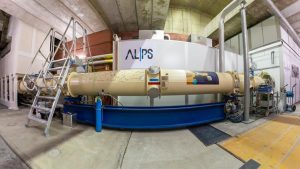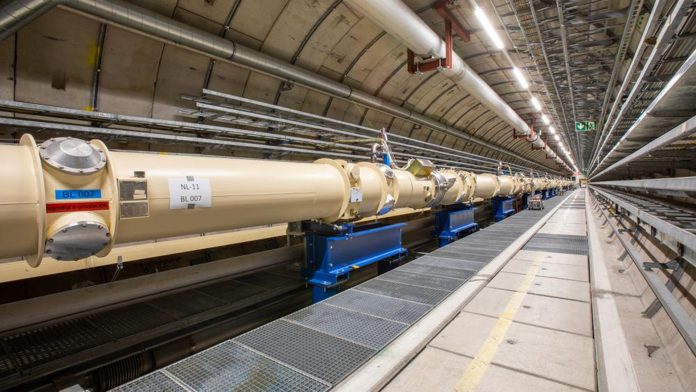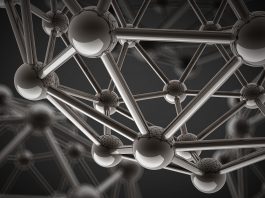The ALPS experiment, the most sensitive model-independent method to search for light particles, has started. Here, we learn more about the experiment.
The ALPS experiment is being carried out at the DESY research centre, and is aiming to detect matter that should occur five times more often in the Universe than normal.
However, until now, no scientist or researcher has been able to identify particles of this substance. The new experiment could be the first of its kind to detect particularly light particles and furnish evidence about their occurrence.
The Innovation Platform takes a look at the experiment and examines how it can reveal unique mysteries about our Universe.
How does the ALPS experiment differ from other dark matter experiments?
The ALPS experiment stretches a total of 250 metres and is looking for a particularly light type of new elementary particle.
To do this, it uses 24 recycled superconducting magnets from the HERA accelerator, an intense laser beam, precision interferometry, and highly sensitive detectors.
The team hopes that using such a unique composition will enable the machine to detect so-called axions or axion-like particles. These particles are believed to react only extremely weakly with known kinds of matter, which means they cannot be detected in experiments using accelerators.
Therefore, ALPS is resorting to an entirely different principle to detect them. Using a strong magnetic field, photons (particles of light), could be transformed into these mysterious elementary particles and back again.
Beate Heinemann, Director of Particle Physics at DESY, explained: “The idea for the ALPS experiment has been around for over 30 years.
“Using components and the infrastructure of the former HERA accelerator, together with state-of-the-art technologies, means we can use ALPS in an international collaboration for the first time.”
Helmut Dosch, Chairman of DESY’s Board of Directors, added: “DESY has set itself the task of decoding matter in all its different forms. Therefore, ALPS fits our research strategy perfectly, and perhaps it will push open the door to dark matter.”
Looking for axions
To detect axion matter, the ALPS experiment will send a high-intensity laser beam along an optical resonator device in a vacuum tube, which is approximately 120m in length.
Here, the beam is reflected both backwards and forwards and enclosed by 12 HERA magnets arranged in a straight line. If a photon were to turn into an axion in the strong magnetic field, that axion could pass through the opaque wall at the end of the line of magnets. Once through the wall, it would enter another magnetic track almost identical to the first.
In this track, the axion can change back into a photon, which the detector can capture at the end. A second optical resonator is set up here to increase the probability of an axion turning back into a photon by a factor of 10,000. This means, if light does arrive behind the wall, it must have been an axion in between.

“However, despite all our technical tricks, the probability of a photon turning into an axion and back again is very small,” commented Axel Lindner, DESY’s project leader and spokesperson of the ALPS collaboration.
Lindner added: “It is like throwing 33 dice and them all coming up the same.”
Making changes to refine the search
For the ALPS experiment to work properly, the team had to tweak all the different components of the apparatus to maximum performance.
When at maximum performance, the experiment has several benefits:
- The light detector is so sensitive that it can detect a single photon per day;
- The precision of the system of mirrors for the light is also record-breaking. The distance between the mirrors must remain constant to within a fraction of an atomic diameter relative to the wavelength of the laser; and
- The superconducting magnets, each nine metres long, generate a magnetic field of 5.3 Tesla in the vacuum tube, more than 100,000 times the strength of the Earth’s magnetic field. These were taken from the 6.3km proton ring of the HERA accelerator and upcycled for the ALPS experiment. The magnets were originally curved on the inside and had to be straightened for the experiment so that they could store more laser light, the safety equipment for operating them under superconducting conditions at -269°C has been completely revised.
The ALPS experiment was originally proposed by DESY theoretician Andreas Ringwald, who also underpinned the theoretical motivation for the experiment with his calculations on extending the Standard Model.
He said: “Experimental and theoretical physicists worked together very closely for ALPS. The result is an experiment with a unique potential to discover axions, which we might even use to search for high-frequency gravitational waves.”
The search for axions will originally begin in an attenuated operating mode. This simplifies the search for ‘background light’ that may falsely indicate the presence of axions.
The experiment is due to achieve full sensitivity in the second half of 2023, with the mirror and alternative light systems being upgraded in 2024.
Lindner concluded: “Even if we don’t find any light particles with the ALPS experiment, the experiment will shift the exclusion limits for ultra-light particles by a factor of 1000.”
Please note, this article will also appear in the fourteenth edition of our quarterly publication.









